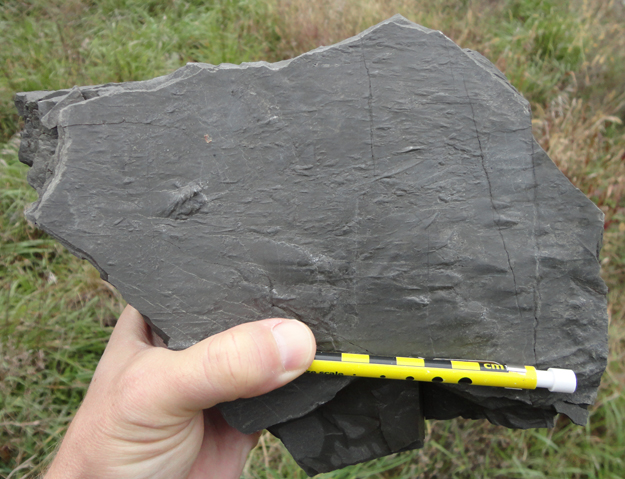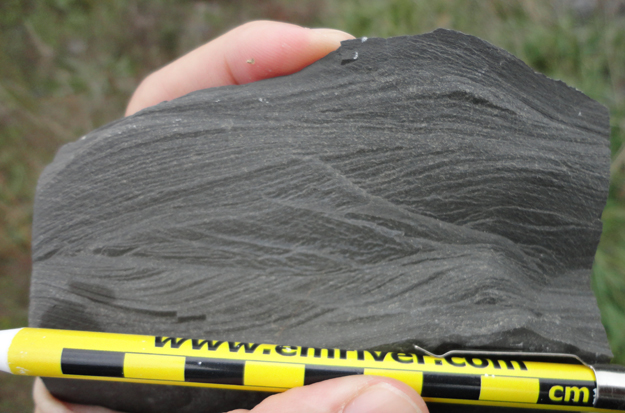8 December 2011
Currents in the Devonian deep
Posted by Callan Bentley
This blog has been noticeably photo deficient lately! Time to remedy that. Today, I offer you a couple of shots of the Brallier Formation (shale / fine-grained sandstone) in West Virginia’s Valley & Ridge province, a few miles northwest of Moorefield, on the newly-opened section of New Route 55. The Brallier was deposited in a deep, low-oxygen portion of the epeiric Kaskaskia Sea.
Flute casts:

Cross-bedding:

These sedimentary rocks were deposited by turbidity currents, high-energy roiling bundles of water, sand, and mud that avalanched down into the deep part of an inland sea during the Devonian period of geologic time. Back then, mountains were being built on the east coast (the Acadian Orogeny) and as those mountains weathered and eroded, they generated lots of sediment. Some of that sediment was deposited on the land, or at the coast, and sometimes high-energy events (perhaps submarine landslides initiated by Acadian earthquakes) took it much further out into the depositional system than “normal.” There, the turbid clouds settled out, producing graded beds and other primary sedimentary structures. The two sedimentary structures shown here are parts of turbidite deposits, collectively called the Bouma sequences. They record currents that had the capacity to erode (gouging out the flutes) and move sediment in a directional current (laying down the cross-beds).
If we listen to them, these rocks speak to us of ancient currents, flowing strongly at times, deep in a sea long deceased.


 Callan Bentley is Associate Professor of Geology at Piedmont Virginia Community College in Charlottesville, Virginia. He is a Fellow of the Geological Society of America. For his work on this blog, the National Association of Geoscience Teachers recognized him with the James Shea Award. He has also won the Outstanding Faculty Award from the State Council on Higher Education in Virginia, and the Biggs Award for Excellence in Geoscience Teaching from the Geoscience Education Division of the Geological Society of America. In previous years, Callan served as a contributing editor at EARTH magazine, President of the Geological Society of Washington and President the Geo2YC division of NAGT.
Callan Bentley is Associate Professor of Geology at Piedmont Virginia Community College in Charlottesville, Virginia. He is a Fellow of the Geological Society of America. For his work on this blog, the National Association of Geoscience Teachers recognized him with the James Shea Award. He has also won the Outstanding Faculty Award from the State Council on Higher Education in Virginia, and the Biggs Award for Excellence in Geoscience Teaching from the Geoscience Education Division of the Geological Society of America. In previous years, Callan served as a contributing editor at EARTH magazine, President of the Geological Society of Washington and President the Geo2YC division of NAGT.
These look great! Any hints on getting to that outcrop? Have been thinking about updating the Historical Geology field trip, and this would be a more-than-mere-replacement for the Martinsburg turbidites near Hagerstown on 70 N.
Easy to get to — drive to the very end of the publicly open stretch of new Route 55 (west of Moorefield). It’s the last outcrop before the bulldozers. These were both seen on the south side of the road, but there’s equivalent exposures on the north side.
Cool! I love the last photo.
[…] more than primary structures in the Devonian-aged Brallier Formation turbidites of West Virginia’s Valley & Ridge province. You can also see some cool […]
Hmmm, deep water, anerobic, Dev???
Any soft tissue preservation in the formation?
There certainly could be – I’ve seen itty bitty brachiopods from elsewhere in the Brallier, but we didn’t see any fossils at all at this particular outcrop.
very nice, looking forward to looking at these strata
Getting caught up on the blog. Those flute casts look awfully familiar.
Post a link to the Gigapan you shot of it, Robin!
[…] More evidence of currents in the Devonian deep… […]